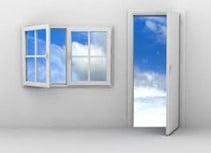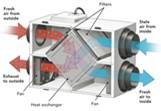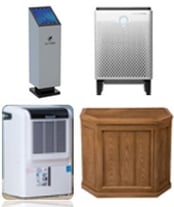Note: Simon Ren, P.E., CEM, serves on the Detroit ASHRAE COVID-19 Task Force with Jim Newman, Sonya Pouncy and others. This article comes from a similar piece written for the Task Force. Members of the Task Force have been speaking to various business and building owner groups on their expertise as it pertains to mitigating the effects of the coronavirus in buildings. Find additional resources at DetroitAshrae.org/COVID_19_task_force.
Portable air cleaners are a viable option for improving air quality in older buildings.
Many older buildings lack whole-building ventilation tied directly into the mechanical operations and HVAC systems. Instead, these older buildings rely on infiltration/exfiltration through cracks in the building envelope, open windows where possible, or toilet or general exhaust fans. Building managers can only hope they will provide at least a minimal amount of outside air. People entering and leaving the building also cause some exchange of outside air with indoor air, but it only happens when people actually come or go. For many low-occupancy spaces this is adequate - most of the time.
How can we improve air quality and increase the amount of outside air in these older buildings, especially as we continue to face a global pandemic brought on by tiny particles that float through the air?

Some will bring in additional outside air by opening windows or doors. Typically, only one window needs to be opened to exchange air in a small space. In larger spaces, opening windows along one wall is sometimes sufficient. For adequate ventilation in a large space, however, we recommend opening windows on opposite sides, or at least two sides of the space. Be aware - uncontrolled variable air movement can spread bacteria and viruses making open windows a less-than-perfect option.
 Because air is mostly empty space, as molecules of indoor air leave (taking contaminants with them) outdoor air (much less likely to be carrying viruses) will enter. Just like the aroma of good (or bad!) cooking that travels quickly throughout a home (especially when there are hungry teenage boys at home), air is constantly in motion and molecules move in and out of spaces. With colder temperatures coming, open windows are less of an option in much of the northern hemisphere, but could provide some needed relief in the southern US and places further toward the equator.
Because air is mostly empty space, as molecules of indoor air leave (taking contaminants with them) outdoor air (much less likely to be carrying viruses) will enter. Just like the aroma of good (or bad!) cooking that travels quickly throughout a home (especially when there are hungry teenage boys at home), air is constantly in motion and molecules move in and out of spaces. With colder temperatures coming, open windows are less of an option in much of the northern hemisphere, but could provide some needed relief in the southern US and places further toward the equator.
Modern Methods to Increase Airflow
Fortunately, today we have access to a variety of mechanical and electronic technologies that reduce pathogens and other pollutants within the space.
- Energy recovery ventilators are an excellent way to bring in outside air. These small, relatively inexpensive units exhaust inside air while bringing in outside air through a heat exchanger. Using this method, owners avoid the larger cost of a make-up air unit with heater.
In Michigan and other northern zones, however, bringing in more outside air during colder winter months reduces relative humidity (RH) within the space, which could pose a problem. Humidity ideally should be between 40 to 60% RH for optimum human health. Below 40% RH, our nasal passages and lung linings dry out making us more susceptible to pathogens.
See "100% Outside Air - Is it Really One of the Best Solutions for Flushing Buildings?"
If bringing in cold air using energy recovery ventilators reduces RH in your building, consider adding humidifiers. For small spaces, portable humidifiers adequately address this. For larger spaces, wall-mounted humidifiers can be installed. On colder days, i.e., below 25°F, it is difficult to maintain 40% RH due to the risk of condensation that can lead to mold in the walls and around the windows. Temporarily reducing the humidifier setting to a lower RH (below 40% but not less than 30%) helps protect the building envelope. - Other options: Portable media filters with high MERV-rated filters, typically HEPA-type (MERV 15) are usually the first technology considered, but they are not effective against gases, odors and the smallest particles. To make them more effective they need to have either a UV lamp or the proper type of ionization of the air, e.g., bi-polar ionization (BPI) or photocatalytic oxidation (PCO). The ions will actually go out into the space to inactivate the bacteria or virus that have not passed through the filter.
See "Three Coronavirus Prevention Techniques – a Comparison" Portable filtration units with HEPA filters and a UV lamp or with ionizers have proven to be much more effective at reducing risk of spreading viruses. The ionizers release positive and negative ions into the space where they instantly oxidize pollutants and inactivate or kill pathogens providing safer, cleaner air to breathe.
Portable filtration units with HEPA filters and a UV lamp or with ionizers have proven to be much more effective at reducing risk of spreading viruses. The ionizers release positive and negative ions into the space where they instantly oxidize pollutants and inactivate or kill pathogens providing safer, cleaner air to breathe.
Do your research. For those in an older building with poor ventilation, one of these systems may be right for you. Before buying a portable air purifier, check whether it is certified by the California Air Resources Board (CARB). They look at electrical safety, ozone emissions and more. If you have questions on which system is right for you, please contact us and one of our indoor air quality experts will help you determine the best system for your situation.
For questions, contact Newman Consulting Group. If you want to reach Simon Ren, use our Contact Form here.


